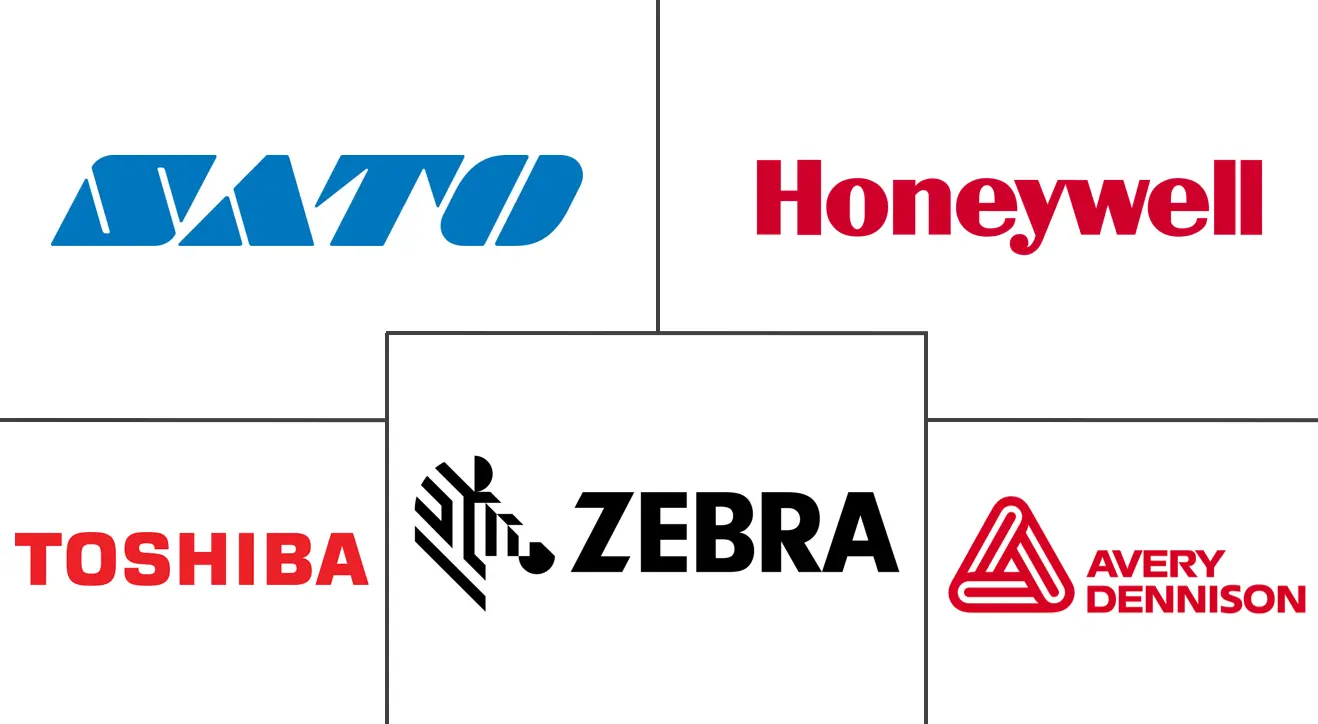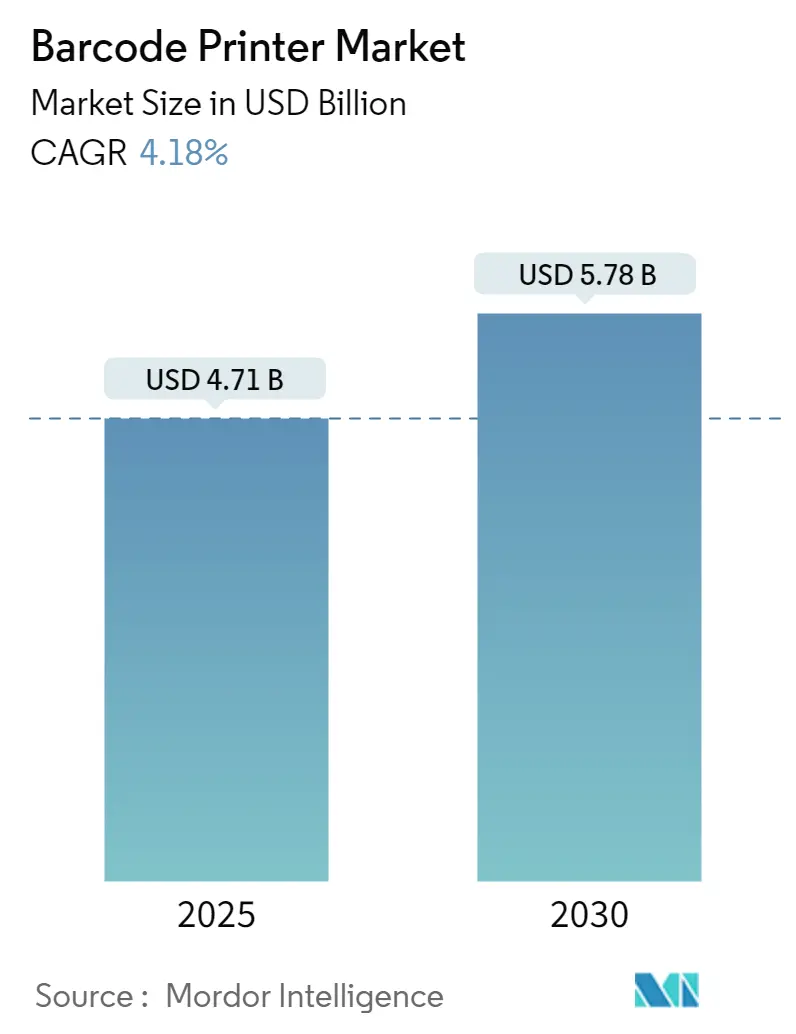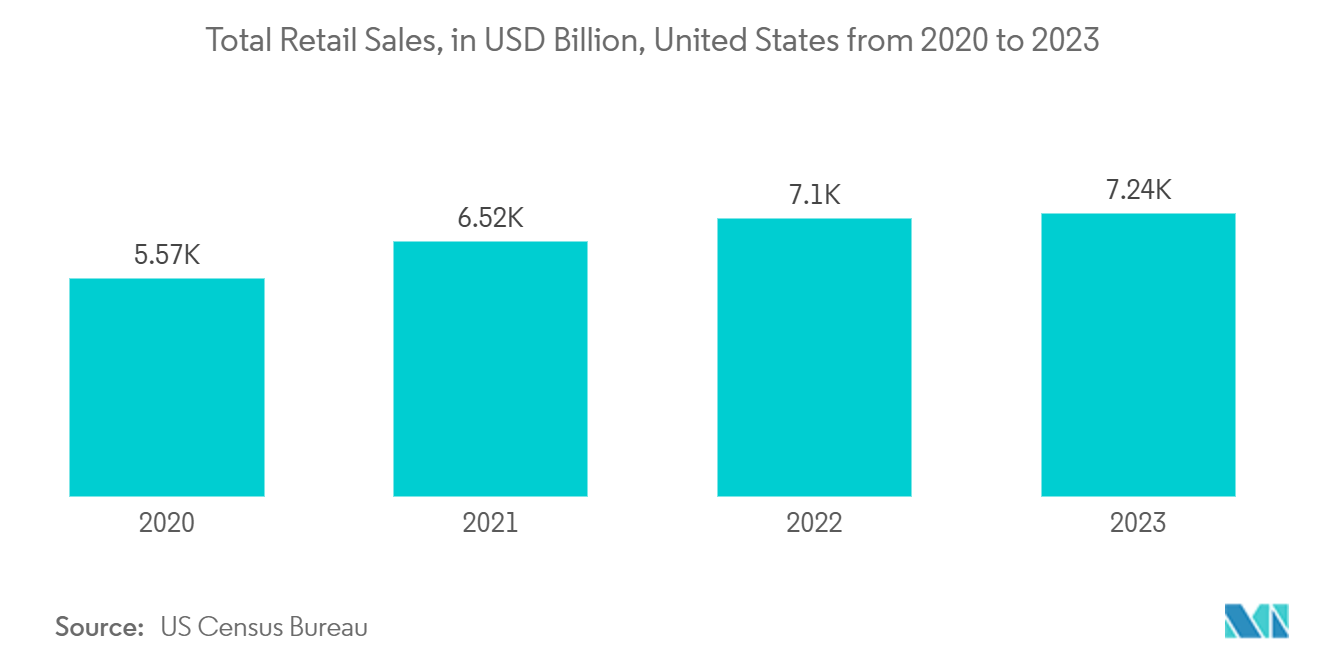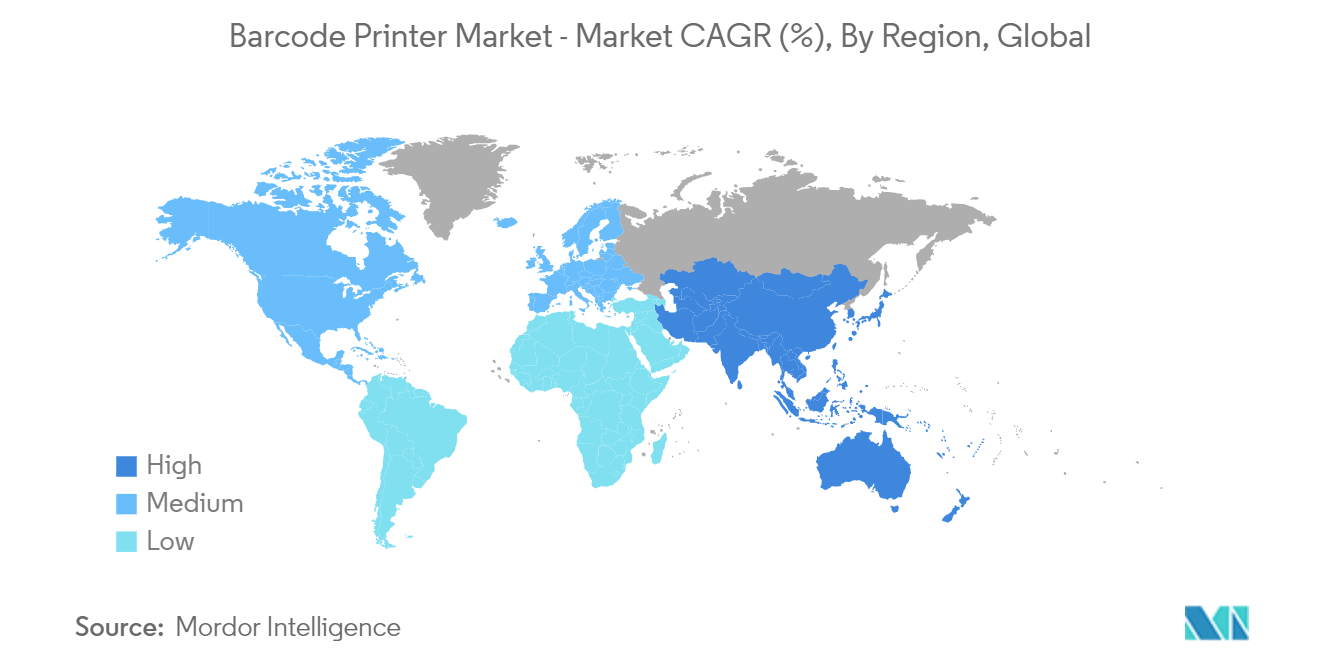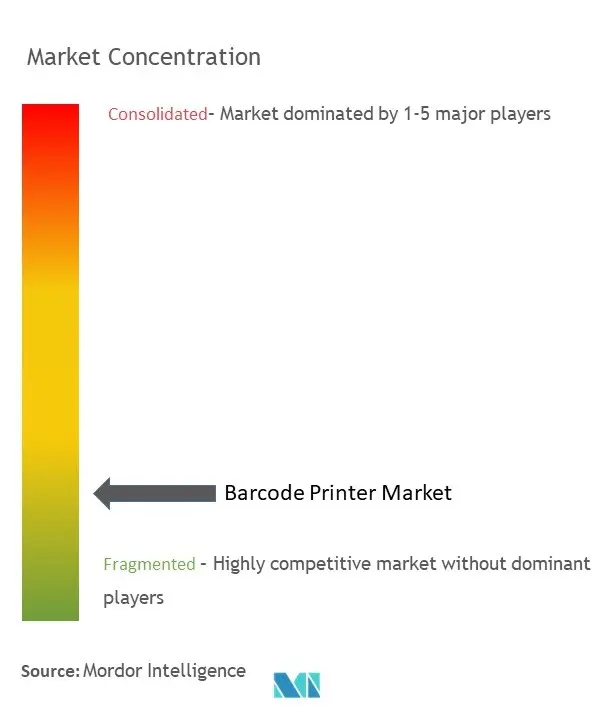Barcode Printer Market Analysis
The Barcode Printer Market size is worth USD 4.71 Billion in 2025, growing at an 4.18% CAGR and is forecast to hit USD 5.78 Billion by 2030.
Increased adoption is the driving force behind the growth of barcode printers as they make logistics operations more efficient. When barcode printers are used to monitor products in distribution chains, they also help store Internet of Things and serial number information while the product is moving between channels to keep that information available for future use. This is an essential factor that encourages the adoption of barcode printers.
- Increasing incidents of theft and fraud in consumer goods and pharmaceuticals are fueling growth in the barcode label printers market. Utilizing barcode tags has simplified logistics and supply chain management by aiding in inventory control, smooth cargo movement in distribution networks, and monitoring manufacturing and assembly processes.
- A barcode is capable of recognizing the order and retrieving details like items in the package, recipient's name, shipping address, and shipping method. Therefore, e-commerce barcode solutions utilize labels to communicate this required information for the successful completion of the entire procedure.
- Moreover, changes are happening in the retail, industrial, and healthcare fields. In the retail industry, consumers seek individually tailored interactions and seamless multichannel buying processes. In May 2024, EM Microelectronic and SATO Corporation revealed that SATO's CL4NX and CL6NX Plus industrial printers, as well as CT4-LX desktop printers, can now print and encode em|echo-V RAINFC labels, catering to retail, healthcare, and smart industrial sectors.
- The use of barcodes in green technology is an innovative way to minimize waste and support sustainability by monitoring and controlling the life cycle of items and resources. Barcodes are common symbols that store details like product name, cost, maker, and expiry date. Consumers and businesses can use a smartphone or dedicated device to scan barcodes and access extra information and services to aid in decreasing their environmental footprint.
- In addition, the costs associated with poor printing of labels are reduced by barcode printers since they can use barcode verifiers. Those verifiers ensure that the output is of good quality in all respects. The barcode printer offers a quick payback period in the form of ROIs. Thus, demand for barcode printers in the supply chain industry is projected to increase during the forecast period. The printing regulations ensure that printing techniques are environmentally friendly.
- The barcode cannot be read or written, and it does not contain any additional information, such as expiration date. Only the manufacturer and the product are included in it. However, the use of barcodes can be very demanding since they must be scanned individually, which could affect the market's growth.
Barcode Printer Market Trends
Retail Segment to be the Largest End-user Industry
- Retail stores utilize barcode printers to print each product's barcode on a self-adhesive tag for ease of scanning by barcode scanners before attaching them to packages or tags. Once the products are gathered in a warehouse associated with their individual SKUs, they are labeled with unique barcodes for better organization of merchandise data in retailer systems, improved inventory management, and tracking of sales transactions at cash registers. The store then has the option to use a barcode label printer to print the barcode alone on the label or include additional details such as price or a brief product description.
- Barcodes allow retailers to manage inventory, automate product reordering, analyze sales of national brands versus private labels, monitor product attribute preferences, tailor promotions to customer buying habits, and identify individual customer preferences.
- Direct transfer printers are perfect for businesses that require efficient barcode printing, as they are able to rapidly produce a high volume of barcodes. They can be used on a variety of surfaces, such as plastic, paper, and metal, due to their flexibility. Directly connecting barcode printers are becoming increasingly popular in retail stores due to their fast and accurate printing of barcoded products and labels.
- Barcode technology allows retailers to monitor their stocks, analyze sales of comparable items, track product details like size and hue, automatically reorder products, recognize customer preferences, and create personalized promotions based on shopping behaviors.
- As per the US Census Bureau's data, total retail sales hit about USD 7.24 trillion by the conclusion of 2023, marking an increase of around USD 1.5 billion compared to the previous year.
North America Holds a Major Market Share
- Due to the widespread use of barcode and label technologies across various industries, North America is recognized as one of the leading investors and innovators in the market. Furthermore, suppliers have a significant opportunity to enter regional markets because of the expansion of end-user industries in the region. Players from the United States comprise a significant portion of the major participants in the regional market. There is a significant amount of innovation in the regional market.
- The expansion of the e-commerce and retail industries in the United States and Canada, with a focus on online shopping, is projected to increase the need for barcode printers in North America as companies prioritize automating processes to enhance operational efficiency. The US Census Bureau had estimated that e-commerce sales in the United States would hit around USD 275 million in 2023.
- With the ongoing growth of healthcare services and the adoption of digital advancements in the United States, it is crucial to have precise and easy-to-use solutions to prioritize patient care. Barcoding solutions and future-proof options are accessible for hospitals, pharmacies, and labs to handle the challenges posed by a growing or aging population.
- Furthermore, the Digimarc barcode has been approved by the US Department of Agriculture as a digital disclosure method for packaging bioengineered foods, also referred to as genetically modified organisms (GMOs). Digimarc Barcode is an innovative form of inconspicuous barcode designed to be included on product packaging, retail tags, and hangtags. Consumer phones that are compatible, as well as retail barcode scanners and computer vision systems, have the capability to scan them. It also removes the requirement of incorporating a QR method in the product package design and meets the updated federal regulations.
Barcode Printer Industry Overview
The competitive rivalry in the fragmented barcode printers market is high owing to some key players such as Zebra Technologies Corporation, Avery Dennison Corporation, Honeywell International Inc., Toshiba Tec Corporation, and Sato Holdings Corporation. Their ability to develop their products constantly has enabled them to compete more effectively with their competitors.
- December 2023: Toshiba added the new BV400T thermal transfer printer range to its lineup of desktop barcode solutions, offering a wide range of features to improve labeling applications. The BV400T allows for ribbon compatibility with 100 m on 1⁄2" and 300 m on 1" cores, offering a wide variety of desktop printing solutions for thermal transfer applications.
- November 2023: TEKLYNX International revealed that it had finished Zebra Technologies' Enterprise Testing Program for its range of software solutions, including barcode label design and print automation. This classification signifies to customers and partners that TEKLYNX software has been thoroughly tested, verifying its compatibility and efficiency with Zebra's industrial thermal transfer barcode label printers.
Barcode Printer Market Leaders
-
Zebra Technologies Corporation
-
Avery Dennison Corporation
-
Honeywell International Inc.
-
Toshiba Tec Corporation
-
Sato Holdings Corporation
- *Disclaimer: Major Players sorted in no particular order
Barcode Printer Market News
- May 2024: Epson launched its latest ColorWorks® on-demand color label printer to address businesses' requirements for inexpensive color labels. Designed specifically for running batches of mid to high-volume jobs in on-demand settings, the ColorWorks CW-C8000 provides excellent printing quality, dependable operation, and fast printing speeds, along with advanced connectivity and cloud printing capabilities.
- January 2024: Citizen Systems America Corporation revealed the latest models in its industrial barcode and POS printer series: the CL-S700III, CT-S801III, and CT-S851III. The CL-S700III is an upgraded version of the popular CL-S700 series, ideal for manufacturing, logistics, and warehouse settings. Enhanced ease of use is obtained with a new color LCD touch screen that includes features such as print previewing, shortcuts, and the innovative Live Forms features.
Barcode Printer Industry Overview
A barcode printer is a computer peripheral for printing barcode labels or tags that can be attached to or printed directly on physical objects. Barcode printers are widely used for labeling packaging prior to delivery or labeling goods with UPCs and EANs.
The barcode printers market is segmented by product type (desktop printer, mobile printer, and industrial printer), printing type (thermal transfer, direct thermal, and other printing types), end-user industry (manufacturing, retail, transportation and logistics, healthcare, and other end-user industries), and geography (North America, Europe, Asia-Pacific, Latin America, and Middle East and Africa). The market sizes and forecasts are provided in terms of value (USD) for all the above segments.
| By Product Type | Desktop Printer |
| Mobile Printer | |
| Industrial Printer | |
| By Printing Type | Thermal Transfer |
| Direct Thermal | |
| Other Printing Types | |
| By End-user Industry | Manufacturing |
| Retail | |
| Transportation and Logistics | |
| Healthcare | |
| Other End-user Industries | |
| By Geography*** | North America |
| Europe | |
| Asia | |
| Australia and New Zealand | |
| Latin America | |
| Middle East and Africa |
Barcode Printer Market Research Faqs
How big is the Barcode Printer Market?
The Barcode Printer Market size is worth USD 4.71 billion in 2025, growing at an 4.18% CAGR and is forecast to hit USD 5.78 billion by 2030.
What is the current Barcode Printer Market size?
In 2025, the Barcode Printer Market size is expected to reach USD 4.71 billion.
Who are the key players in Barcode Printer Market?
Zebra Technologies Corporation, Avery Dennison Corporation, Honeywell International Inc., Toshiba Tec Corporation and Sato Holdings Corporation are the major companies operating in the Barcode Printer Market.
Which is the fastest growing region in Barcode Printer Market?
Asia Pacific is estimated to grow at the highest CAGR over the forecast period (2025-2030).
Which region has the biggest share in Barcode Printer Market?
In 2025, the North America accounts for the largest market share in Barcode Printer Market.
What years does this Barcode Printer Market cover, and what was the market size in 2024?
In 2024, the Barcode Printer Market size was estimated at USD 4.51 billion. The report covers the Barcode Printer Market historical market size for years: 2019, 2020, 2021, 2022, 2023 and 2024. The report also forecasts the Barcode Printer Market size for years: 2025, 2026, 2027, 2028, 2029 and 2030.
Our Best Selling Reports
Barcode Printer Industry Report
Statistics for the 2025 Barcode Printer market share, size and revenue growth rate, created by Mordor Intelligence™ Industry Reports. Barcode Printer analysis includes a market forecast outlook for 2025 to 2030 and historical overview. Get a sample of this industry analysis as a free report PDF download.

